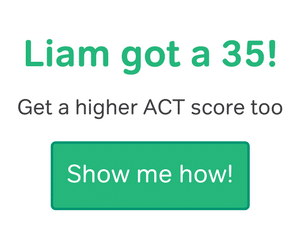So…how many questions can you miss for a perfect ACT score? You can get up to five questions wrong on the ACT (or skip them—the test doesn’t deduct points in either case, so they count the same towards your score) and still get a perfect score of 36.
That statement, though, has to be heavily qualified! For instance, those five questions? They’d have to be in precise categories/sections of the exam for you to still get a 36. So, actually, there are only handful of scenarios in which you could miss these questions and still get that top score.
And I’m sure you’re wondering by now: Just what might these scenarios look like? Let’s take a brief overview of them before looking at strategies to help you get that perfect score and what a 36 is really worth.
How Many Questions Can You Miss For a Perfect ACT Score?
| ACT Test Section | Scenario 1: Maximum Wrong Answers by Section | Scenario 2: Maximum Wrong Answers by Section | Scenario 3: Maximum Wrong Answers by Section | Scenario 4: Maximum Wrong Answers by Section | Scenario 5: Maximum Wrong Answers by Section | Scenario 6: Maximum Wrong Answers by Section |
|---|---|---|---|---|---|---|
| English | 2 | 2 | 2 | 0 | 0 | 0 |
| Math | 3 | 0 | 0 | 3 | 3 | 0 |
| Reading | 0 | 1 | 0 | 1 | 0 | 1 |
| Science | 0 | 0 | 1 | 0 | 1 | 1 |
Keep in mind that you could, in theory, have a different wrong answer distribution in different sections and still end up with a 36—these are just a few sample scenarios.
Caveat Emptor…
In the first place, we definitely don’t recommend going into the test thinking “I can get x number of questions wrong and still get a perfect score!” In the second place, the best strategy is to try your best on every question.
However. Let’s say as a matter of academic interest, you wanted to know how we came up with the above scenarios for how many questions you can miss and still get a perfect score on the ACT—not for your own personal use, mind you, but rather just out of curiosity.
A perfect composite (overall) score on the ACT is 36. This 36 is the average of four subscores from the sections that make up the larger test: English, Math, Reading, and Science.
Perfection on the ACT by Subject
To get a perfect 36 in English, you can’t get any questions wrong. In Math, you can miss one. In Reading, you can’t get any wrong; ditto in Science.
Don’t despair, perfectionists! Remember, your total score is the average of your subscores from the four different categories. This is great news for those of you aiming for a 36, because you could get a 35 in two categories if you got a 36 in the other two, and it would average out to a 36 (rounded up from 35.5).
(If you are also aiming for a perfect 36 on the ACT essay, check this out.)
A Loophole to an ACT 36?
Strangely enough, the number of questions you can get wrong on the ACT and still get a perfect composite score varies by which section you get them wrong in. For a 35 in English, you can get up to two questions wrong. In Math, you can miss up to three. In Reading and Science, it’s one per section. As you may have guessed by now, these are the facts we used to compile the table of scenarios above.
The two categories that provide us with the maximum flexibility, therefore, are English and Math: combined, you could get five questions wrong (two in English, three in Math) and score 35s in both sections, while getting perfect 36s in Reading and Science. If we flip that around and you have 35s in Reading and Science (missing one question per section) and 36s in Math and English (missing one question and no questions), you could only get three questions wrong.
How to Get a PERFECT Score on the ACT
Okay, I’m going to make a drastic suggestion here—what if we forgot all about the questions you can get wrong here and focus on the questions you’ll get right? After all, that’s the best way to get a perfect score…
With that in mind, here are some valuable tips.
Tip 1: Take as Many Practice Tests as You Can.
I’m talking a dozen or more if possible. Definitely take all the official ACT tests available to you in the 3rd edition of The Real Guide, but also take the practice PDF test on the ACT website and do all the practice questions on the website as well. In addition, you can complete practice questions and tests from quality ACT prep resources such as Magoosh! You can also hunt down older editions of The Real Guide or practice with released official tests you can get from friends or tutors who have used the Test Information Release service.
The reason many, many practice tests are particularly helpful for the ACT is because the ACT is very repetitive and predictable–it uses the same question types over and over (and over). The rationales behind the correct answer choices are often equally as predictable. But a certain oddball question type might not repeat itself for a few tests, so you want to make sure you have as much exposure to ACT questions as possible.
Tip 2: Remember You Don’t Have to Get Every Question Right to Get a Perfect Score.
I know that you’re already pretty aware of this right now, but it’s important to remember on test day, as well! Why?
Well, first of all it means don’t freak out and get hung up on one troublesome question and waste time you could be spending on others. Make eliminations, take your best guess and focus on the rest of the questions.
It also means that for a perfect score, you want to make sure you are really focusing on your strengths. I am sure you are very strong across the board if you are shooting for a 36, but you might feel more comfortable with English instead of Science, for example. This means you need to be VERY careful on English. Don’t get overconfident: take your full time on the sections that are typically a breeze for you, read very carefully, and practice good test taking strategies. Because if you want a perfect composite score, you are going to want to make sure you get a perfect section score in your strongest subjects.
Tip 3: Practice Seeing the Test from the Test Makers’ Perspective.
This means considering where they are expecting you to trip up and also how they create answer choices that can be defended as irrefutably correct. So after you do practice tests, don’t just check off all the questions you got right and move on. If you are scoring in the upper 30s already, you aren’t going to learn as much as you need to by just reviewing the handful of questions you got wrong. Instead, go back through the entire test and look at the answer choices for each question. Look at things such as how the test makers’ are creating tempting wrong answer choices on each individual section and how they test the same concepts over and over. Check to see if there is a smarter strategy you could have employed to get the answer faster. Thinking about the test from the test makers’ perspective will help you avoid expected traps and help you finish questions more quickly so you have time to check your work.
Bonus Tip: Let It Go.
Finally, remember that getting a perfect score is really, really hard, and really, really rare. And it seriously requires a stroke of good luck—you need the stars to perfectly align on your particular administration of the test. Only about 1400 out of the 1.8 million students who took the ACT in last year’s graduating class got a perfect score. So it’s possible, but don’t beat yourself up over it. A perfect 36 is a cool thing, but it isn’t the end-all, be-all of ACT scores.
Nevertheless, following these tips hopefully will help you increase your odds of a perfect score–or at least get you a little bit closer. And, as a bonus, someday you will make an amazing ACT tutor. 🙂
For even more tips to get that perfect (or very high) score, Magoosh’s ACT expert, Kristin, has some advice:
Video: How to Get a Perfect Score on the ACT
ACT Expert, Kristin Fracchia, shows you how to get a perfect score on the ACT in English, Math, Reading, Science and Writing in this video from Magoosh.
The Final Final Answer
All in all: if you want to get a perfect score on the ACT, you’re better off studying than worrying about how many questions you can get wrong and still achieve that score. However, if you must know: you can get between three and five questions wrong and still get a perfect score on the ACT, depending on the category in which you get them wrong.
PS For those of you confused about how the 1-36 ACT score works—after all, there aren’t exactly 36 questions in any section—we explain it a little more here.
Need more help?
With Magoosh ACT, you can choose between a live cohorted class with an instructor (which includes all our lessons and practice questions) or access to the self-study option by itself.






Leave a Reply